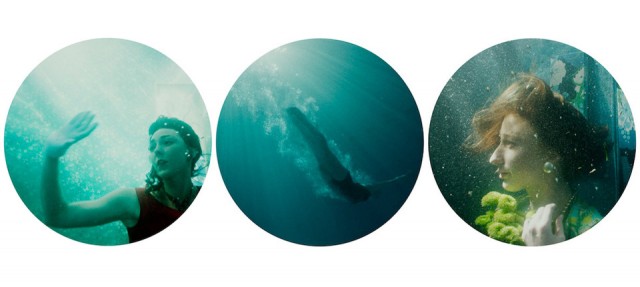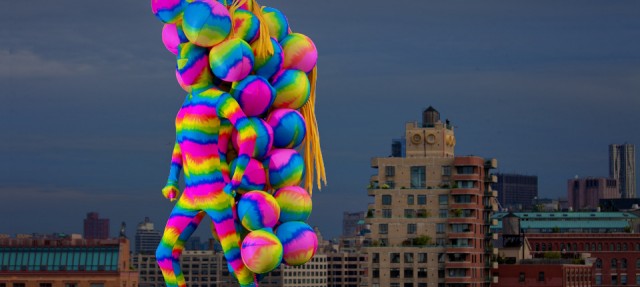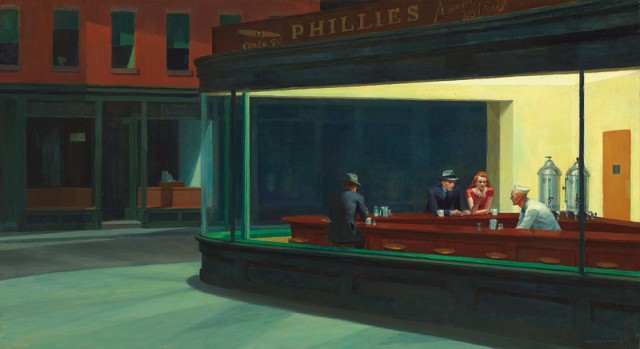
Edward Hopper, “Nighthawks,” oil on canvas, 1942 (Friends of American Art Collection, Art Institute of Chicago)
Whitney Museum of American Art
945 Madison Ave. at 75th St.
Wednesday – Sunday through October 6, $16-$20 (pay-what-you-wish Fridays, 6:00 – 9:00)
212-570-3600
www.whitney.org
There are only five days left to see the most exciting room in any New York City museum right now, the centerpiece of the Whitney’s “Hopper Drawing” exhibit, which continues through Sunday. Although the primary focus of the show is the New York realist’s drawings and preparatory sketches, the well-curated display also includes two of Edward Hopper’s greatest paintings, installed across from each other in a spacious gallery. On one wall hangs Hopper’s most famous work, 1942’s “Nighthawks,” a bravura noir oil of light, shadow, and color in which a lone man and a couple sit at a diner counter being served by a male worker in white. Every detail in the masterful composition, inspired by a Greenwich Village street and, perhaps, the Flatiron Building, is a wonder to observe. Seeing it in this context, the viewer is able to remove all of the meta surrounding the work, the endless parodies, homages, rip-offs, and tributes that keep coming and instead just appreciate the dazzling glory of the original. It’s a genuine treat to see “Nighthawks” in New York, as it’s on loan from the Art Institute of Chicago, where it’s been ever since Daniel Catton Rich bought it from Hopper for three thousand dollars shortly after it was completed. On May 13, 1942, Hopper sent a letter to Rich, explaining, “It is, I believe, one of the very best things I have painted. I seem to have come nearer to saying what I want to say in my work, this past winter, than I ever have before.”
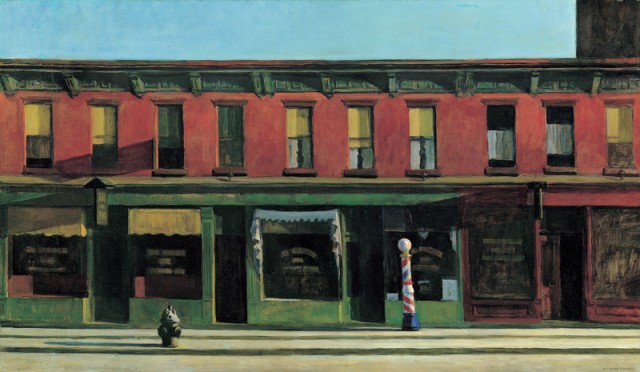
Edward Hopper, “Early Sunday Morning,” oil on canvas, 1930 (© Heirs of Josephine N. Hopper, licensed by the Whitney Museum of American Art)
On the other side of the room, in the corner on a platform, resides one of the other very best things Hopper painted, the Whitney’s own “Early Sunday Morning.” Placed on Hopper’s easel in the corner, echoing the architectural layout in “Nighthawks,” the 1930 oil painting depicts a depression-era Seventh Ave. devoid of people as dawn breaks. Hopper re-creates a horizontal two-story building, the ground floor consisting of closed businesses with blurred names, the second floor comprising apartments with shades drawn at different levels, implying some kind of life going on inside. A fire hydrant and a barbershop pole, along with an unseen element, cast shadows, while an ominous dark rectangle in the upper right corner, contrasting with the blue of the sky, portends to the coming of monstrous skyscrapers that would signal the end of small-town living. The canvas’s deceptive simplicity is both devastating and mesmerizing, worthy of extended viewing that is sure to produce powerful emotional reactions. “Early Sunday Morning” marvelously captures an America teetering between the Great Depression and FDR’s New Deal, a moment in time when the future was as uncertain as it’s ever been. Perhaps some of those people missing in “Early Sunday Morning” found themselves still lost a dozen years later, sitting silently in a dark corner diner, wondering where things might have gone wrong. Related drawings, audio, video, and wall text further explore the creative process Hooper employed in both works, including trying to find the precise geographic locations that influenced these majestic paintings, which, seen together, shed even more light on their brilliance.

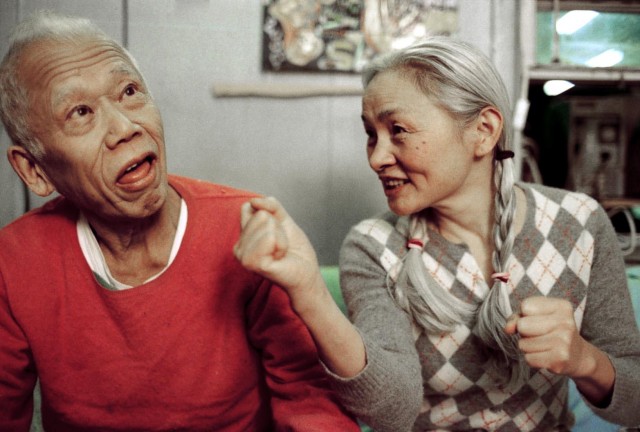
 Zachary Heinzerling’s
Zachary Heinzerling’s 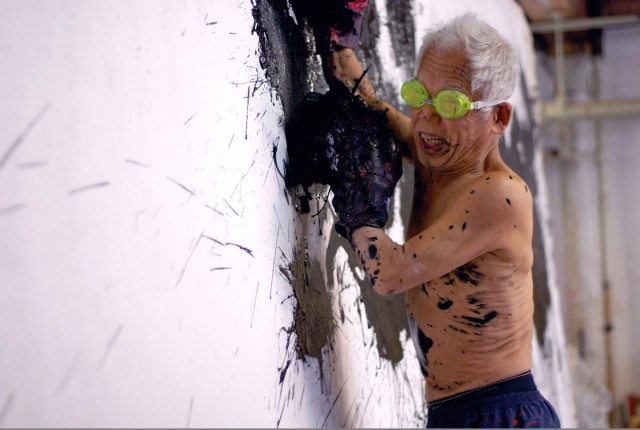





 Oh yes, there will be blood. Tim Burton’s adaptation of the hit Broadway musical Sweeney Todd is bloody good fun. After being sent to prison for fifteen years by Judge Turpin (Alan Rickman), who had designs on his wife (Laura Michelle Kelly), innocent barber Benjamin Barker (Johnny Depp) returns to nineteenth-century London, reborn as Sweeney Todd, now a dark, ominous figure dead set on gaining his dastardly revenge. He gets back his coveted silver razors, which he considers an extension of his arm, and sets up shop in his old place, above the store where Mrs. Lovett (Helena Bonham Carter) sells meat pies crawling with cockroaches. When Todd begins slicing throats with expert precision, Lovett has a novel way of doing away with the bodies — while increasing business. Burton and screenwriter John Logan (The Aviator, The Last Samurai) terrifically translate the show onto the big screen, as Depp, Bonham Carter, and the rest of the cast — including Sacha Baron Cohen as a magical elixir salesman, Timothy Spall as the judge’s wingman, and Jayne Wisener as Todd’s daughter, who is doomed to marry the judge — do a wonderful job with such Stephen Sondheim songs as “No Place Like London,” “Poor Thing,” “My Friends,” “Pretty Women,” and “Not While I’m Around.” Depp is marvelous as the demon barber of Fleet Street, wearing a fright wig with a shocking streak of white, singing most of his dialogue with a gentle devilishness, enhanced by his haunting, penetrating eyes. The goth opera not only sounds good but looks even better, courtesy of cinematographer Dariusz Wolski, Oscar-winning production designer Dante Ferretti, and costume designer Colleen Atwood. Burton and Depp, who previously collaborated on Edward Scissorhands, Ed Wood, Sleepy Hollow, Charlie and the Chocolate Factory, and Corpse Bride, have another winner on their hands. Sweeney Todd is screening September 30 at 4:00 as part of the MoMA series “Dante Ferretti: Designing for the Big Screen,” being held in conjunction with the exhibit “Dante Ferretti: Design and Construction for the Cinema” and continues through February 9 with such other fab-looking works as Pier Paolo Pasolini’s Medea, Federico Fellini’s City of Women, and Julie Taymor’s Titus.
Oh yes, there will be blood. Tim Burton’s adaptation of the hit Broadway musical Sweeney Todd is bloody good fun. After being sent to prison for fifteen years by Judge Turpin (Alan Rickman), who had designs on his wife (Laura Michelle Kelly), innocent barber Benjamin Barker (Johnny Depp) returns to nineteenth-century London, reborn as Sweeney Todd, now a dark, ominous figure dead set on gaining his dastardly revenge. He gets back his coveted silver razors, which he considers an extension of his arm, and sets up shop in his old place, above the store where Mrs. Lovett (Helena Bonham Carter) sells meat pies crawling with cockroaches. When Todd begins slicing throats with expert precision, Lovett has a novel way of doing away with the bodies — while increasing business. Burton and screenwriter John Logan (The Aviator, The Last Samurai) terrifically translate the show onto the big screen, as Depp, Bonham Carter, and the rest of the cast — including Sacha Baron Cohen as a magical elixir salesman, Timothy Spall as the judge’s wingman, and Jayne Wisener as Todd’s daughter, who is doomed to marry the judge — do a wonderful job with such Stephen Sondheim songs as “No Place Like London,” “Poor Thing,” “My Friends,” “Pretty Women,” and “Not While I’m Around.” Depp is marvelous as the demon barber of Fleet Street, wearing a fright wig with a shocking streak of white, singing most of his dialogue with a gentle devilishness, enhanced by his haunting, penetrating eyes. The goth opera not only sounds good but looks even better, courtesy of cinematographer Dariusz Wolski, Oscar-winning production designer Dante Ferretti, and costume designer Colleen Atwood. Burton and Depp, who previously collaborated on Edward Scissorhands, Ed Wood, Sleepy Hollow, Charlie and the Chocolate Factory, and Corpse Bride, have another winner on their hands. Sweeney Todd is screening September 30 at 4:00 as part of the MoMA series “Dante Ferretti: Designing for the Big Screen,” being held in conjunction with the exhibit “Dante Ferretti: Design and Construction for the Cinema” and continues through February 9 with such other fab-looking works as Pier Paolo Pasolini’s Medea, Federico Fellini’s City of Women, and Julie Taymor’s Titus.